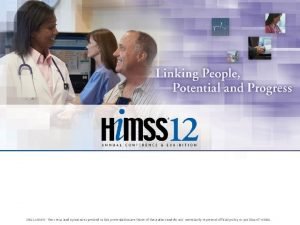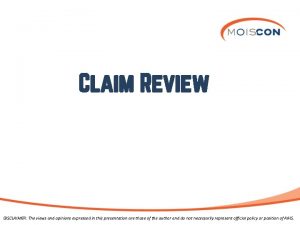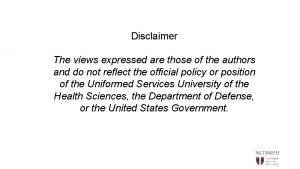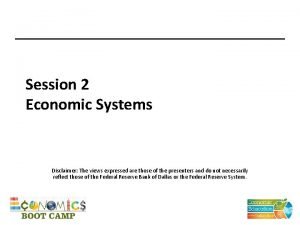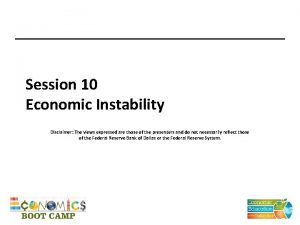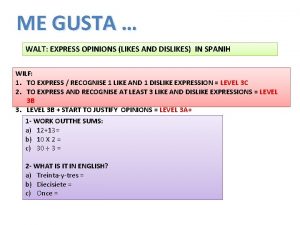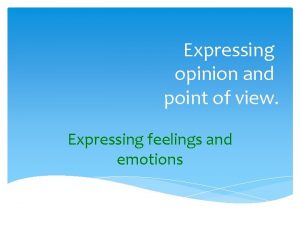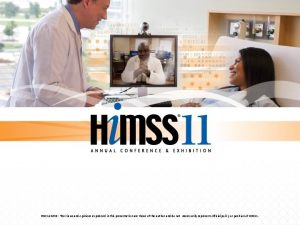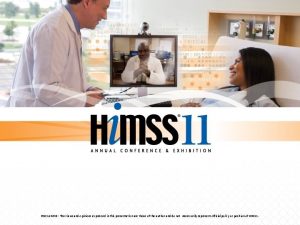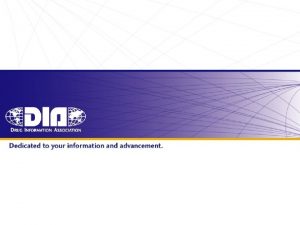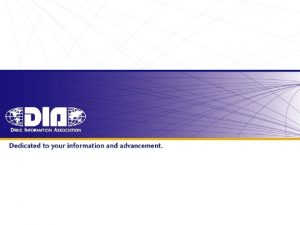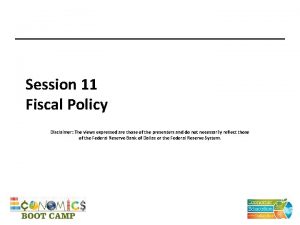Disclaimer The views opinions and content expressed in















































- Slides: 47


Disclaimer The views, opinions, and content expressed in this presentation do not necessarily reflect the views, opinions, or policies of the Center for Mental Health Services (CMHS), the Substance Abuse and Mental Health Services Administration (SAMHSA), or the U. S. Department of Health and Human Services (HHS). 2

Crisis Now: Transforming Services is Within Our Reach August 9, 2017

Presenters David Covington, LPC, MBA (RI International) Thomas Betlach, Director of the Arizona Health Care Cost Containment System (AHCCCS)

Crisis Now: What It Is A report that summarizes the findings of the Crisis Services Task Force of the National Action Alliance for Suicide Prevention (Action Alliance) about the essential elements of effective, modern, and comprehensive crisis care, and the actions needed to bring it to communities across the United States. The report describes the: • status, • needs and • opportunities… for mental health crisis care.

Crisis Now: Sections 1. Regional 24/7 Hub/Crisis Call Center; 2. Mobile Crisis Teams; 3. Crisis Stabilization Facilities; 4. Essential Qualities; a. Recovery, peers and trauma-informed b. Suicide Safer Care c. Safety and Security d. Law Enforcement and Crisis System Training/Coord. 5. Financing Crisis Care; and 6. Strategic Directions.

Crisis Now: Why It’s Needed • Escalating Cost of Inpatient Behavioral Health Treatment; • Headline: “ 8 in 10 ER Docs Say Mental Health System is Not Working for Patients”; • ACEP Survey Concludes that Boarding Wait Times for Psychiatric Inpatient Needs to be Reduced; • The increasing dependence on… hospital EDs to provide behavioral evaluation and treatment is not appropriate, not safe, and not an efficient use of dwindling community emergency resources.

Crisis Now: Why It’s Needed • Good crisis care is a known effective strategy for suicide prevention, a preferred strategy for the person in distress, a key element to reduce psychiatric hospital bed overuse, and crucial to reducing the fragmentation of mental health care. • With non-existent or inadequate crisis care, costs go up due to increased dependence on inpatient treatment, hospital readmissions, emergency department resources used for boarding, overuse of law enforcement to address crisis issues, incarceration and human tragedies that include suicide.

Crisis Now: Preventable Tragedies • Thousands of Americans dying alone and in desperation from suicide • Unspeakable family pain • Psychiatric “boarding” • The wrong care in the wrong place, delivered in a way that compromises other medical urgent care • Law enforcement working as “mobile crisis”

Crisis Now: Development The Task Force was launched in July of 2015 and composed of 31 leaders in the field of crisis services. David Covington Michael Hogan Jason H. Padgett Bart Andrews Leon Boyko Lisa Capoccia Lynn Copeland Barbara Dawson Susan Dess Steven Dettwyler Bea Dixon John Draper Phil Evans Gerald Fishman Vijay Ganju Larry Goldman Gabriella Guerra Brian Hepburn Shannon Jaccard Helen Lann Nick Margiotta Richard Mc. Keon Tim Mechlinski Steve Miccio Heather Rae John Santopietro Wendy Schneider Cheryl Sharp Becky Stoll Eduardo Vega James Wright

Crisis Now: A Business Case Thousands of crisis call come in each month and… • 66% are resolved by phone; • 48% of advanced referrals resolved by Mobile team; • 70% of referrals to crisis facility resolved without referral to acute hospital; • Results in 95% of crisis contacts being resolved within the crisis system (hospital diversion)… • Decreasing the number of individuals who might otherwise be admitted for inpatient care or even incarcerated.

Crisis Now: Four Core Elements for Transforming Crisis Services 1. High-tech Statewide Crisis Call Centers; 2. Centrally Deployed Mobile Crisis on a 24/7 Basis; 3. Residential Crisis Stabilization Programs; and 4. Essential Crisis Care Principles and Practices.

What is your “Crisis Now” readiness? A Framework for State/Regional Self-Assessment For more info see http: //crisisnow. com ① Call Center Hub ② Mobile Outreach Sub-acute ③ Stabilization Crisis Now System Meets Person at Home/Apt/Stre et Direct LE Drop Off <10 Min Air Traffic Control Connectivity Adequate Access Statewide Level 4: CLOSE Data Sharing (Not 24/7 or Real Time) Statewide Access but Reliant on ED Adequate Access Statewide Plus Integrated System w/ Diversion Power Level 3: PROGRESSING Formal Partnerships Adequate Access <1 Hr Response Adequate Access >50% Bed Available Adequate Access Major Payers Included Level 2: BASIC Shared MOU/ Protocols Some Availability Limited to Urban Limited State/ County Support None or Very Limited Availability Fragmented Status Quo What makes Level 5 different? Level 5: FULLY INTEGRATED Level 1: MINIMAL Real Time Access Valve Mgmt Agency Relationships Equal Partners 1 st Responders Level 5 System Also Conforms to 4 Modern Principles ① Priority Focus on Safety/Security ② Suicide Care Best Practices, e. g. Systematic Screening, Safety Planning and Follow-up ③ Trauma. Informed, Recovery Model ④ Significant Role for Peers

What is your “Crisis Now” readiness? A Framework for State/Regional Self-Assessment For more info see http: //crisisnow. com ① Call Center Hub ② Mobile Outreach Sub-acute ③ Stabilization Crisis Now System Meets Person at Home/Apt/Stre et Direct LE Drop Off <10 Min Air Traffic Control Connectivity Adequate Access Statewide Level 4: CLOSE Data Sharing (Not 24/7 or Real Time) Statewide Access but Reliant on ED Adequate Access Statewide Plus Integrated System w/ Diversion Power Level 3: PROGRESSING Formal Partnerships Adequate Access <1 Hr Response Adequate Access >50% Bed Available Adequate Access Major Payers Included Level 2: BASIC Shared MOU/ Protocols Some Availability Limited to Urban Limited State/ County Support None or Very Limited Availability Fragmented Status Quo What makes Level 5 different? Level 5: FULLY INTEGRATED Level 1: MINIMAL Real Time Access Valve Mgmt Agency Relationships Equal Partners 1 st Responders Level 5 System Also Conforms to 4 Modern Principles ① Priority Focus on Safety/Security ② Suicide Care Best Practices, e. g. Systematic Screening, Safety Planning and Follow-up ③ Trauma. Informed, Recovery Model ④ Significant Role for Peers

What is your “Crisis Now” readiness? A Framework for State/Regional Self-Assessment For more info see http: //crisisnow. com ① Call Center Hub ② Mobile Outreach Sub-acute ③ Stabilization Crisis Now System Meets Person at Home/Apt/Stre et Direct LE Drop Off <10 Min Air Traffic Control Connectivity Adequate Access Statewide Level 4: CLOSE Data Sharing (Not 24/7 or Real Time) Statewide Access but Reliant on ED Adequate Access Statewide Plus Integrated System w/ Diversion Power Level 3: PROGRESSING Formal Partnerships Adequate Access <1 Hr Response Adequate Access >50% Bed Available Adequate Access Major Payers Included Level 2: BASIC Shared MOU/ Protocols Some Availability Limited to Urban Limited State/ County Support None or Very Limited Availability Fragmented Status Quo What makes Level 5 different? Level 5: FULLY INTEGRATED Level 1: MINIMAL Real Time Access Valve Mgmt Agency Relationships Equal Partners 1 st Responders Level 5 System Also Conforms to 4 Modern Principles ① Priority Focus on Safety/Security ② Suicide Care Best Practices, e. g. Systematic Screening, Safety Planning and Follow-up ③ Trauma. Informed, Recovery Model ④ Significant Role for Peers

What is your “Crisis Now” readiness? A Framework for State/Regional Self-Assessment For more info see http: //crisisnow. com ① Call Center Hub ② Mobile Outreach Sub-acute ③ Stabilization Crisis Now System Meets Person at Home/Apt/Stre et Direct LE Drop Off <10 Min Air Traffic Control Connectivity Adequate Access Statewide Level 4: CLOSE Data Sharing (Not 24/7 or Real Time) Statewide Access but Reliant on ED Adequate Access Statewide Plus Integrated System w/ Diversion Power Level 3: PROGRESSING Formal Partnerships Adequate Access <1 Hr Response Adequate Access >50% Bed Available Adequate Access Major Payers Included Level 2: BASIC Shared MOU/ Protocols Some Availability Limited to Urban Limited State/ County Support None or Very Limited Availability Fragmented Status Quo What makes Level 5 different? Level 5: FULLY INTEGRATED Level 1: MINIMAL Real Time Access Valve Mgmt Agency Relationships Equal Partners 1 st Responders Level 5 System Also Conforms to 4 Modern Principles ① Priority Focus on Safety/Security ② Suicide Care Best Practices, e. g. Systematic Screening, Safety Planning and Follow-up ③ Trauma. Informed, Recovery Model ④ Significant Role for Peers

What is your “Crisis Now” readiness? A Framework for State/Regional Self-Assessment For more info see http: //crisisnow. com ① Call Center Hub ② Mobile Outreach Sub-acute ③ Stabilization Crisis Now System Meets Person at Home/Apt/Stre et Direct LE Drop Off <10 Min Air Traffic Control Connectivity Adequate Access Statewide Level 4: CLOSE Data Sharing (Not 24/7 or Real Time) Statewide Access but Reliant on ED Adequate Access Statewide Plus Integrated System w/ Diversion Power Level 3: PROGRESSING Formal Partnerships Adequate Access <1 Hr Response Adequate Access >50% Bed Available Adequate Access Major Payers Included Level 2: BASIC Shared MOU/ Protocols Some Availability Limited to Urban Limited State/ County Support None or Very Limited Availability Fragmented Status Quo What makes Level 5 different? Level 5: FULLY INTEGRATED Level 1: MINIMAL Real Time Access Valve Mgmt Agency Relationships Equal Partners 1 st Responders Level 5 System Also Conforms to 4 Modern Principles ① Priority Focus on Safety/Security ② Suicide Care Best Practices, e. g. Systematic Screening, Safety Planning and Follow-up ③ Trauma. Informed, Recovery Model ④ Significant Role for Peers

What is your “Crisis Now” readiness? A Framework for State/Regional Self-Assessment For more info see http: //crisisnow. com ① Call Center Hub ② Mobile Outreach Sub-acute ③ Stabilization Crisis Now System Meets Person at Home/Apt/Stre et Direct LE Drop Off <10 Min Air Traffic Control Connectivity Adequate Access Statewide Level 4: CLOSE Data Sharing (Not 24/7 or Real Time) Statewide Access but Reliant on ED Adequate Access Statewide Plus Integrated System w/ Diversion Power Level 3: PROGRESSING Formal Partnerships Adequate Access <1 Hr Response Adequate Access >50% Bed Available Adequate Access Major Payers Included Level 2: BASIC Shared MOU/ Protocols Some Availability Limited to Urban Limited State/ County Support None or Very Limited Availability Fragmented Status Quo What makes Level 5 different? Level 5: FULLY INTEGRATED Level 1: MINIMAL Real Time Access Valve Mgmt Agency Relationships Equal Partners 1 st Responders Level 5 System Also Conforms to 4 Modern Principles ① Priority Focus on Safety/Security ② Suicide Care Best Practices, e. g. Systematic Screening, Safety Planning and Follow-up ③ Trauma. Informed, Recovery Model ④ Significant Role for Peers

Arizona Crisis System Overview Thomas Betlach, Director of the Arizona Health Care Cost Containment System

Arizona Overview • Expanded Medicaid in 2000 – restored in 2014 • 1. 9 m enrollees – 28% of state population • 50% of population are adults 19 -64 • Largely Managed Care • Incrementally integrating BH carve-out • Required to have competitive procurements Reaching across Arizona to provide comprehensive quality health care for those in need

AHCCCS Care Delivery System Reaching across Arizona to provide comprehensive quality health care for those in need

Current RBHA GSAs

Integration Efforts 100% 80% 60% 40% 20% 0% Oct-12 Apr-13 Oct-13 Apr-14 Oct-14 Apr-15 Oct-15 Apr-16 Oct-16 Apr-17 Oct-17 ALTCS EPD CRS SMI - MMIC SMI - GAZ GMH/SA Duals AIHP FFS (7/1/16) ALTCS DD GMH/SA Adults Non-CMDP Children Reaching across Arizona to provide comprehensive quality health care for those in need Apr-18 Oct-18 Apr-19

Crisis System Principles • • Coordinated System of Entry Community Based Recovery Oriented Member Focused Reaching across Arizona to provide comprehensive quality health care for those in need

The Contractor Shall • • • Establish a 24 X 7 Crisis Response System Establish timely access to Crisis Telephone Services Establish mobile Crisis Services Establish Stabilizations Services Stabilize individuals and assist in return to their baseline level of functioning • Assess individuals needs and identify supports & services • Provide recovery oriented interventions designed to avoid unnecessary hospitalizations, incarcerations or placement in more segregated settings Reaching across Arizona to provide comprehensive quality health care for those in need

The Contractor Shall • Not require Prior Auth for Crisis Services • Develop local stabilization services to prevent unnecessary transport • Coordinate with local tribes for delivery of crisis services on tribal lands • Participate in data sharing across the system • Collaborate with – Police – Fire – EMS – Hospital EDs – Other payers – public health • Support training annually for law enforcement • Report data on call volume – resolution – Dispatch of services – mobile team response time Reaching across Arizona to provide comprehensive quality health care for those in need

Call Center Requirements • Establish a single Toll Free # • Publicize the number throughout region – handbook – website – newsletter • Answer calls in 3 rings or less – abandonment rate less than 3% • Patch capability to 911 • Follow-up call within 72 hours • Offer interpretive or language translation • Provide nurse on call 24 hour coverage Reaching across Arizona to provide comprehensive quality health care for those in need

Mobile Crisis Requirements • Ability to travel to place where person is in crisis • Ability to assess and provide intervention • Meet diverse needs of population – youth – Individuals with Developmental Disabilities – Stabilization of acute symptoms of Mental Illness, alcohol and other drugs • When clinically indicated transport to more appropriate placement • On site within 90 minutes Crisis call – Develop incentives for teams to make it in 45 minutes Reaching across Arizona to provide comprehensive quality health care for those in need

Stabilization Requirement • Offer 24 X 7 SUD and psychiatric stabilization including 23 hour crisis stabilization observation • Provider short term – up to 72 hour stabilization services instead of transition to higher level • Provide a crisis and assessment stabilization service in settings consistent with requirements to have an adequate and sufficient network including Level 1 Acute – BH residential – outpatient clinics • Daily communication on bed availability in system Reaching across Arizona to provide comprehensive quality health care for those in need

Crisis System Services Call Centers $22. 0 m Mobile Crisis $45. 0 m Stabilization Services $95. 0 m Total $165. 0 m Reaching across Arizona to provide comprehensive quality health care for those in need

Crisis System Funding Sources State Only Funding $35. 0 m SABG $5. 0 m TXIX $125. 0 m Total $165. 0 m Reaching across Arizona to provide comprehensive quality health care for those in need

Select Example Call Center Data Reporting Total Calls for Month 14, 259 Resolved by Phone 9, 782 Secured Transportation 2, 435 Mobile Team Dispatch 1, 853 911 Called 109 Referral to Community Resources 283 Reaching across Arizona to provide comprehensive quality health care for those in need

Select Data for Mobile Dispatch Resolved with Mobile Team 1, 207 Referred to Facility 253 911 64 Police request Mobile Transport Initiated Petition Process 260 48 Reaching across Arizona to provide comprehensive quality health care for those in need

The Future – Request for Information AHCCCS recognizes that significant investment has been made to develop a variety of responsive crisis service delivery methods throughout the state. AHCCCS is committed to maintaining a robust crisis system that incorporates telephone crisis triage and intervention, community-based mobile teams, facility-based observation and stabilization, crisis transportation, hospital rapid response and rapid response for children in foster care. A multitude of structural options exist for the crisis system including the RBHA in each region continuing to control and coordinate crisis services as currently outlined in contract or a requirement that all Contractors go through one statewide crisis vendor to control and coordinate a statewide crisis system that incorporates the various delivery methods that are currently operational. Additionally, crisis line options include maintaining the existing structure in which RBHAs contract with a regional crisis line or the contracting of a single statewide crisis line vendor. Reaching across Arizona to provide comprehensive quality health care for those in need

Provider Perspective • David Covington CEO RI International

Ubiquitous and inexpensive technology is changing nearly every other industry.

Big data and basic principles of coordination lead to an extraordinary level of safety for air travelers.

Carolinas Health. Care designed with safety, privacy, and trauma-informed care principles.

RI International believes the first step is a welcoming and comfortable space.

Modern Crisis Care Changes the Paradigm FROM TO Absence of data and coordination Publicly available data in real-time on ED wait times, access, crisis bed dashboards availability, and outcomes “Cold” referrals to mental health care rarely followed up, and people slip through the cracks Direct connections and 24/7 realtime scheduling EDs are the default mental health crisis center Mobile crisis provides a response that often avoids ED visits and institutionalization

Modern Crisis Care Changes the Paradigm FROM TO Jails are a de facto crisis alternative; police transport to distant hospitals takes law enforcement off the beat and is unpleasant and stigmatizing for people in crisis Crisis service settings—the urgent care units for mental health look more like home settings and also provide a reliable partner for law enforcement Despair and isolation worsened by Crisis care with support and trust: trying to navigate the mental health what the person wants and needs, system maze where the person wants and needs it

What is your “Crisis Now” readiness? A Framework for State/Regional Self-Assessment For more info see http: //crisisnow. com ① Call Center Hub ② Mobile Outreach Sub-acute ③ Stabilization Crisis Now System Meets Person at Home/Apt/Stre et Direct LE Drop Off <10 Min Air Traffic Control Connectivity Adequate Access Statewide Level 4: CLOSE Data Sharing (Not 24/7 or Real Time) Statewide Access but Reliant on ED Adequate Access Statewide Plus Integrated System w/ Diversion Power Level 3: PROGRESSING Formal Partnerships Adequate Access <1 Hr Response Adequate Access >50% Bed Available Adequate Access Major Payers Included Level 2: BASIC Shared MOU/ Protocols Some Availability Limited to Urban Limited State/ County Support None or Very Limited Availability Fragmented Status Quo What makes Level 5 different? Level 5: FULLY INTEGRATED Level 1: MINIMAL Real Time Access Valve Mgmt Agency Relationships Equal Partners 1 st Responders Level 5 System Also Conforms to 4 Modern Principles ① Priority Focus on Safety/Security ② Suicide Care Best Practices, e. g. Systematic Screening, Safety Planning and Follow-up ③ Trauma. Informed, Recovery Model ④ Significant Role for Peers

The Arizona Video Let’s watch the 7 minute and 40 second video from http: //crisisnow. com/thevideo/

Polling Question: How does your state’s crisis system rate? A Framework for State/Regional Self-Assessment For more info see http: //crisisnow. com ① Call Center Hub ② Mobile Outreach Sub-acute ③ Stabilization Crisis Now System Meets Person at Home/Apt/Stre et Direct LE Drop Off <10 Min Air Traffic Control Connectivity Adequate Access Statewide Level 4: CLOSE Data Sharing (Not 24/7 or Real Time) Statewide Access but Reliant on ED Adequate Access Statewide Plus Integrated System w/ Diversion Power Level 3: PROGRESSING Formal Partnerships Adequate Access <1 Hr Response Adequate Access >50% Bed Available Adequate Access Major Payers Included Level 2: BASIC Shared MOU/ Protocols Some Availability Limited to Urban Limited State/ County Support None or Very Limited Availability Fragmented Status Quo What makes Level 5 different? Level 5: FULLY INTEGRATED Level 1: MINIMAL Real Time Access Valve Mgmt Agency Relationships Equal Partners 1 st Responders Level 5 System Also Conforms to 4 Modern Principles ① Priority Focus on Safety/Security ② Suicide Care Best Practices, e. g. Systematic Screening, Safety Planning and Follow-up ③ Trauma. Informed, Recovery Model ④ Significant Role for Peers

Download the report at crisisnow. com

Thank You!

Questions? Comments? Contact Information David Covington: David. Covington@riinternational. com Thomas Betlach: thomas. betlach@azahcccs. gov Note: A recording of this webinar and a pdf of the slides will be available within 10 days at www. nasmhpd. org/webinars For questions regarding the video, slides or materials/resources presented in the webinar, contact Christy Malik: christy. malik@nasmhpd. org
 Views expressed disclaimer example
Views expressed disclaimer example The views and opinions expressed
The views and opinions expressed Googlemoa
Googlemoa The views and opinions expressed
The views and opinions expressed All opinions expressed disclaimer
All opinions expressed disclaimer The views expressed disclaimer
The views expressed disclaimer Disclaimer the opinions expressed
Disclaimer the opinions expressed The views expressed disclaimer
The views expressed disclaimer Views expressed disclaimer
Views expressed disclaimer Views disclaimer
Views disclaimer Disclaimer the views expressed
Disclaimer the views expressed Disclaimer
Disclaimer Disclaimer for sensitive content
Disclaimer for sensitive content What is esp
What is esp Dynamic content vs static content
Dynamic content vs static content Touchscreen slam poem
Touchscreen slam poem Bertrand russell on avoiding foolish opinions
Bertrand russell on avoiding foolish opinions Past modals for hypothetical situations
Past modals for hypothetical situations Asking and giving opinions
Asking and giving opinions Expressing like and dislike
Expressing like and dislike Expressing opinions and feelings
Expressing opinions and feelings Giving opinions en español
Giving opinions en español Social function asking and giving opinion
Social function asking and giving opinion Fact and opinion about pizza
Fact and opinion about pizza Fact statement example
Fact statement example Hình ảnh bộ gõ cơ thể búng tay
Hình ảnh bộ gõ cơ thể búng tay Frameset trong html5
Frameset trong html5 Bổ thể
Bổ thể Tỉ lệ cơ thể trẻ em
Tỉ lệ cơ thể trẻ em Chó sói
Chó sói Chụp phim tư thế worms-breton
Chụp phim tư thế worms-breton Chúa sống lại
Chúa sống lại Môn thể thao bắt đầu bằng chữ f
Môn thể thao bắt đầu bằng chữ f Thế nào là hệ số cao nhất
Thế nào là hệ số cao nhất Các châu lục và đại dương trên thế giới
Các châu lục và đại dương trên thế giới Công thức tính độ biến thiên đông lượng
Công thức tính độ biến thiên đông lượng Trời xanh đây là của chúng ta thể thơ
Trời xanh đây là của chúng ta thể thơ Mật thư anh em như thể tay chân
Mật thư anh em như thể tay chân 101012 bằng
101012 bằng Phản ứng thế ankan
Phản ứng thế ankan Các châu lục và đại dương trên thế giới
Các châu lục và đại dương trên thế giới Thơ thất ngôn tứ tuyệt đường luật
Thơ thất ngôn tứ tuyệt đường luật Quá trình desamine hóa có thể tạo ra
Quá trình desamine hóa có thể tạo ra Một số thể thơ truyền thống
Một số thể thơ truyền thống Cái miệng nó xinh thế chỉ nói điều hay thôi
Cái miệng nó xinh thế chỉ nói điều hay thôi Vẽ hình chiếu vuông góc của vật thể sau
Vẽ hình chiếu vuông góc của vật thể sau Biện pháp chống mỏi cơ
Biện pháp chống mỏi cơ đặc điểm cơ thể của người tối cổ
đặc điểm cơ thể của người tối cổ

